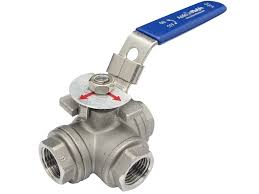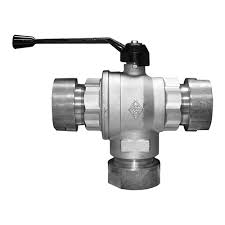A Comprehensive Guide on Three-Way Valve

The Application of Three-Way Valve
Cameron offers a range of Three-Way Valves designed for various industrial applications. Also known as 3 three-way ball valves, these valves provide versatile flow control solutions. A three way ball valve allows for redirection of fluid flow in three different directions, making it suitable for applications where diverting, mixing, or isolating flows is required. Industries such as oil and gas, chemical processing, HVAC, and water treatment utilize valve three way configurations for tasks such as blending different fluids, diverting flow between multiple pipelines, or controlling the direction of flow within a system. With their robust construction and precise control capabilities, three way ball valves from Cameron are trusted for their reliability and performance in various industrial settings.
What Are The Types Of Three-Way Valve?
- T-Shaped Three-Way Valve: This type of valve has a T-shaped configuration, with three ports arranged in the shape of a T. It allows for diversion of flow between two inlet ports and one outlet port, or vice versa.
- L-Shaped Three-Way Valve: L-shaped valves have an L-shaped configuration, with three ports arranged in the shape of an L. They enable flow diversion between one inlet port and two outlet ports, or vice versa.
- Mixing Three-Way Valve: Mixing valves allow for blending or mixing of two different fluid streams. They typically have one inlet port and two outlet ports, allowing for controlled mixing of fluids at different ratios.
- Diverting Three-Way Valve: Diverting valves are used to redirect flow from one inlet port to two different outlet ports, or vice versa. They are commonly used in applications where flow needs to be diverted between multiple pipelines or systems.
What Is Three-Way Valve?
A Three-Way Valve is a type of control valve used in industrial systems to regulate the flow of fluids. Unlike traditional two-way valves that have two ports for inlet and outlet, a Three-Way Valve features three ports, allowing for more versatile flow control. It enables redirection of fluid flow between different pipelines or systems, facilitating tasks such as blending, diverting, or mixing fluids. Three-Way Valves are commonly used in various industries, including oil and gas, chemical processing, water treatment, and HVAC, where precise flow control and versatility are required for efficient operation.
How Does Three-Way Valve work?
Three-Way Valves work by controlling the flow of fluid between three ports. Depending on the valve’s configuration, it can divert, mix, or isolate fluid flow. When the valve is actuated, the internal mechanism redirects the fluid path, allowing it to flow through one of the outlet ports while blocking or redirecting flow from the other ports. This mechanism enables Three-Way Valves to perform various functions, such as blending two different fluids, diverting flow between multiple pipelines, or controlling the direction of flow within a system, providing flexibility and versatility in industrial applications.
Features of Three-Way Valve
- Versatility: Three-Way Valves offer versatility in fluid flow control, allowing for redirection, mixing, or isolation of flow between three ports, providing flexibility in various industrial processes.
- Space-Saving Design: They have a compact design compared to using multiple two-way valves, saving space and simplifying piping configurations.
- Cost-Efficiency: By combining multiple functions into a single valve, Three-Way Valves offer cost savings in terms of equipment, installation, and maintenance.
- Reduced Leak Points: With fewer connections compared to using multiple valves, Three-Way Valves help reduce potential leak points, enhancing system reliability and safety.
- Enhanced Control: They provide precise control over fluid flow direction and distribution, allowing for optimized process performance and efficiency.
- Durable Construction: Built with robust materials and components, Three-Way Valves offer durability and reliability even in demanding industrial environments.
- Easy Installation: They are designed for easy installation and maintenance, with standardized connections and simple operation mechanisms.
- Wide Range of Applications: Suitable for various industries such as oil and gas, chemical processing, water treatment, HVAC, and more, Three-Way Valves find applications where versatile flow control is essential.
Advantages of Three-Way Valve
- Versatility: Three-Way Valves offer versatile fluid flow control, enabling redirection, mixing, or isolation of flow between three ports in a single valve.
- Space-Saving: Their compact design saves space compared to using multiple two-way valves, simplifying piping layouts and reducing installation footprint.
- Cost-Effective: Combining multiple functions into a single valve reduces equipment, installation, and maintenance costs compared to using multiple valves.
- Reduced Leak Potential: With fewer connections, Three-Way Valves minimize potential leak points, enhancing system reliability and safety.
- Enhanced Control: They provide precise control over fluid flow direction and distribution, optimizing process performance and efficiency.
- Durability: Built with robust materials and components, Three-Way Valves offer durability and reliability, even in harsh industrial environments.
- Ease of Installation and Maintenance: Designed for easy installation and maintenance, Three-Way Valves feature standardized connections and simple operation mechanisms.
- Wide Range of Applications: Suitable for various industries such as oil and gas, chemical processing, water treatment, HVAC, and more, Three-Way Valves find applications where versatile flow control is essential.

The Specifications of Three-Way Valve
| Specification | Details |
|---|---|
| Type | Three-Way Valve |
| Ball Material | Stainless Steel, Brass, Aluminum, etc. |
| Attachment Type | Flanged, Threaded, Socket Weld, Butt Weld, etc. |
| Thread Standard | ANSI, DIN, JIS, BS, etc. |
| Thread Size | 1/2″, 3/4″, 1″, 1-1/4″, etc. |
| Body Material | Cast Iron, Ductile Iron, Stainless Steel, etc. |
| Safe for Use With | Water, Air, Gas, Various Chemicals |
| Handle Type | Lever, Gear, Actuator |
| Handle Material | Aluminum, Stainless Steel, Brass, etc. |
| Maximum Working Pressure (psi) | Varies based on size and design |
| Maximum Working Pressure (bar) | Varies based on size and design |
| Operating Pressure | Varies based on application requirements |
The Parameter of Three-Way Valve
- Type: Three-Way Valve
- Ball Material: Stainless Steel, Brass, Aluminum, etc.
- Attachment Type: Flanged, Threaded, Socket Weld, Butt Weld, etc.
- Thread Standard: ANSI, DIN, JIS, BS, etc.
- Thread Size: 1/2″, 3/4″, 1″, 1-1/4″, etc.
- Body Material: Cast Iron, Ductile Iron, Stainless Steel, etc.
- Safe for Use With: Water, Air, Gas, Various Chemicals
- Handle Type: Lever, Gear, Actuator
- Handle Material: Aluminum, Stainless Steel, Brass, etc.
- Maximum Working Pressure (psi): Varies based on size and design
- Maximum Working Pressure (bar): Varies based on size and design
- Operating Pressure: Varies based on application requirements
The Operation Theory of Three-Way Valve
The operation theory of Three-Way Valves involves directing fluid flow between three ports to achieve various control functions. In the case of a three way shower valve, it regulates the flow of water between different outlets such as a showerhead, tub spout, and handheld shower. Similarly, a three way pool valve manages the flow of water between a pool, spa, and other water features, ensuring proper circulation and filtration. On the other hand, a three way solenoid valve controls the flow of fluids or gases in industrial automation systems, directing them between different process lines or equipment. Regardless of the specific application, the operation theory remains consistent, with the valve’s internal mechanism diverting flow according to the desired configuration, ensuring efficient flow control and system operation.

